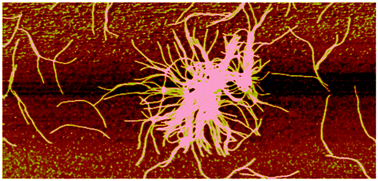DNA driven self-assembly of micron-sized rods using DNA-grafted bacteriophage fd virions†
Abstract
We have functionalized the sides of fd bacteriophage virions with oligonucleotides to induce DNA hybridization driven self-assembly of high aspect ratio filamentous particles. Potential impacts of this new structure range from an entirely new building block in DNA origami structures, inclusion of virions in DNA nanostructures and nanomachines, to a new means of adding thermotropic control to lyotropic liquid crystal systems. A protocol for producing the virions in bulk is reviewed. Thiolated oligonucleotides are attached to the viral capsid using a heterobifunctional chemical linker. A commonly used system is utilized, where a sticky, single-stranded DNA strand is connected to an inert double-stranded spacer to increase inter-particle connectivity. Solutions of fd virions carrying complementary strands are mixed, annealed, and their aggregation is studied using dynamic light scattering (DLS), fluorescence microscopy, and atomic force microscopy (AFM). Aggregation is clearly observed on cooling, with some degree of local order, and is reversible when temperature is cycled through the DNA hybridization transition.


 Please wait while we load your content...
Please wait while we load your content...